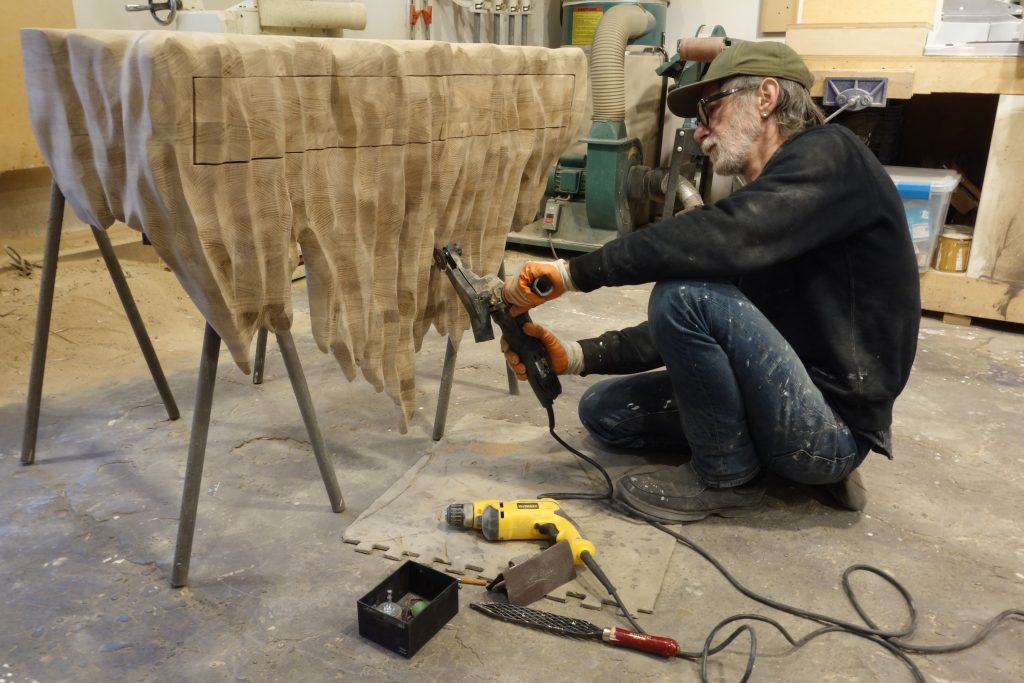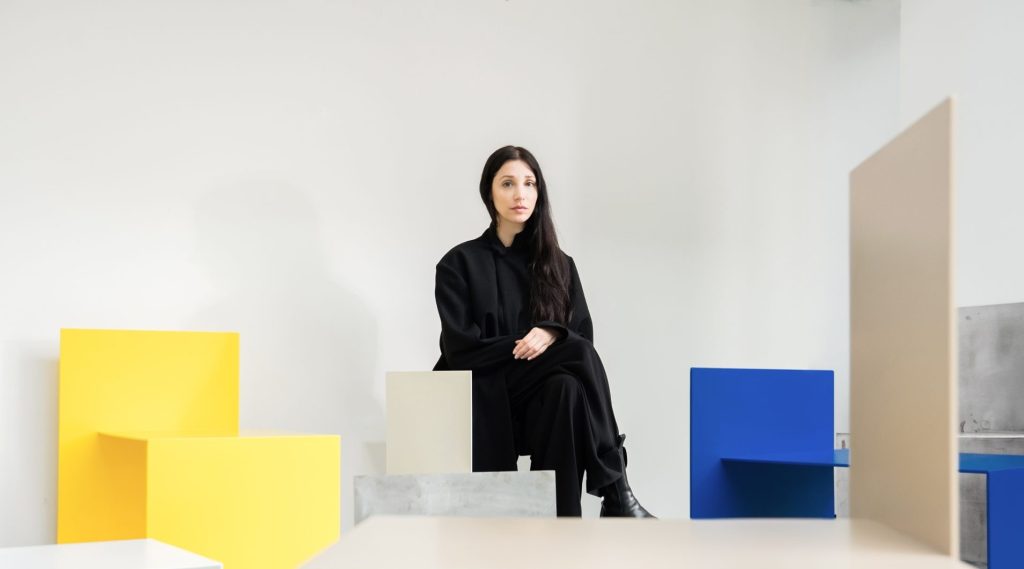

Meet the Curator: ELIEN HAENTJENS, Brussels
Elien Haentjens trained as an Art Historian at the University of Leuven, where she specialized in Modern and Contemporary Art, before completing her education as a journalist at Vlekho in Brussels. Since 2006, she has worked as a freelance journalist specializing in art, lifestyle and especially design, for the most important Belgian magazines and newspapers, including Trends and Feelings. Since 2012, she has also curated and organized exhibitions, mainly in Brazil, to promote the diversity, creativity and quality of Belgian design, and to stimulate valuable cross-cultural relationships. In design, Haentjens is particularly interested in the revitalization of crafts, and exploring ways that traditional artisanal methods can be revitalized and used for contemporary products.
What are the special characteristics of the contemporary design community you are working in?
In addition to Belgium’s flourishing industrial product design scene, the contemporary design sector has also become a very diverse realm of activity, and is integrated fully into Belgian society. This extends from graphic design, to social and UX design, to unique and limited-edition works of collectible design, like those featured on Adorno. Belgium is defined by its vibrant cultural mix — there is an abundance of both German and Latin influences — and this creates a real variety of outcomes. It is difficult to define something as “Belgian design,” although there is always a poetic, emotional and sometimes even surreal touch.


Any special traditions/materials/techniques/historical events in your region that you believe have inspired local designers?
If you were looking for the origin of so-called “design” in Belgium, you would have to go back to the end of the 19th century, when the Art Nouveau movement really took hold here. Leading figures such as Victor Horta and Henry Van de Velde saw their projects as a “gesamtkunstwerk,” or “total works of art.” These designers conceived and created not only the architecture of their buildings, but also the interior. While Victor Horta grew famous for his organic, flamboyant lines, Henry Van de Velde worked according to the idea that form follows function. When the first industrial revolution hit Europe, Belgium was among the best students in the class. Unlike the Arts & Crafts movement in the UK – which believed that machines can only copy, and never make something new — Van de Velde did the opposite: for his products, he took advantage of machines as tools that make design affordable for everybody. This was the start of the industrial design sector.
Around these ideas, Henry Van de Velde not only founded the art school in Weimar – the later Bauhaus – but also La Cambre in Brussels. Until today students are trained according to his ideas. Thanks to this long tradition and the awareness of students, companies and the public about the importance of innovative and qualitative design, the sector reached a high quality.
Especially the last twenty years Belgian design companies gain international attention, and Belgian designers draw products for famous companies. Good examples are Maarten Van Severen, who designed among other things the famous 03.chair for Vitra, and Vincent Van Duysen, who recently became artistic director of the Italian brand Molteni. Thanks to our strong creative tradition, that goes back to the middle ages, pioneering stores and fairs such as Interieur Kortrijk Belgian people value well designed, beautiful and creative objects.


How are the curated pieces you have chosen significant for or emblematic of your region’s design landscape today?
Following the global trend of renewed attention to unique, handmade pieces with a story, Belgium has recently rediscovered the value and nobility of crafts and humble materials. Accordingly, a lot of upcoming designers in Belgium don’t only design their pieces, but they also produce them in their own workshop, or together with dedicated artisans.
What defines your work as a curator?
The constant quest for innovation, not only by developing new materials or techniques, but also by reviving old crafts and techniques through new applications.


How do the designers currently represented in your gallery embody this?
The first designers of the collaboration all use old techniques in order to create their contemporary pieces. For example, Yves Pauwels works with simple metal tubes, which he cuts and manipulates in various ways to produce playful new shapes. For his “Fan Lamps,” which he creates together with local craftsmen in the Philippines, Sep Verboom combined unusable fans with traditional weavings in rattan, which lends a natural touch to the upcycled fan structure.


Although Belgium is a very small European country, the resonance of its creative landscape can be felt far and wide. In the Middle Ages, artists such as Jan van Eyck and Rogier van der Weyden made delicate paintings that are now shown in the most prestigious museums around the world. Later, Pieter Paul Rubens, René Magritte, James Ensor, and Marcel Broodthaers contributed to this rich artistic tradition.
If it comes to textile design, the carpets industry – based on drawings of artists – flourished during the Renaissance. In fashion, the Antwerp Six – with inter alia Dries Van Noten – and Martin Margiela became world famous in the eighties. But also the name of Raf Simons, who has set the tone at Dior and works currently at Calvin Klein, rings probably a bell. And that’s just the beginning.
Form follows function
If we’re looking for the origin of design, we have to go back to the end of the nineteenth century, when the Art Nouveau movement got also the power in Belgium. Leading figures such as Victor Horta and Henry Van de Velde saw their projects as a ‘gesamtkunstwerk’. They not only designed the architecture, but also the interior. While Victor Horta got famous for his organic, flamboyant lines, Henry Van de Velde worked according to the idea ‘form follows function’.
At that time the first industrial revolution hit Europe, and Belgium was among the best students in the class. While in the United Kingdom a movement such as Arts & Crafts – stating machines can only copy and never make something new – gained power among designers, Henry Van de Velde did the opposite: he developed products for which he could take advantage out of the machines as a tool to make design affordable for the daily life of everybody. Together with his philosophy about design, this meant the start of the industrial design sector.
Great diversity
Around these ideas, Henry Van de Velde not only founded the art school in Weimar – the later Bauhaus – but also La Cambre in Brussels. Until today students are trained according to his ideas. Thanks to this long tradition and the awareness of students, companies and the public about the importance of innovative and qualitative design, the sector reached a high quality. Especially the last twenty years Belgian design companies gain international attention, and Belgian designers draw products for famous companies. Good examples are Maarten Van Severen, who designed among other things the famous 03.chair for Vitra, and Vincent Van Duysen, who recently became artistic director of the Italian brand Molteni.
In addition to this industrial production, the contemporary design sector in Belgium became very diverse. It goes from graphic design over social and experience design to unique and limited edition designart pieces, of which you find a selection on Adorno. The significant growth of these collectible pieces went hand in hand with the renewed interest in crafts and unique handmade pieces. Following this trend, a lot of the young designers don’t only design their pieces, but also make them in their own workshop.
Finally, if you’re looking for a typical piece of Belgian design, it will be difficult to find it. As our country is the result of a cultural mix between German and Latin influences – it is divided in a Dutch, French, and smaller German-speaking part -, and as we don’t have a strong nationalistic feeling, the creative outcome can be very different. Although a poetic, emotional and sometimes even surreal touch is never far away.




